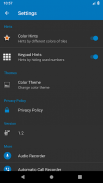










Sudoku

توضیحات Sudoku
Sudoku (digit-single) (originally called Number Place) is a logic-based, combinatorial number-placement puzzle. The objective is to fill a 9×9 grid with digits so that each column, each row, and each of the nine 3×3 subgrids that compose the grid (also called "boxes", "blocks", or "regions") contain all of the digits from 1 to 9. The puzzle setter provides a partially completed grid, which for a well-posed puzzle has a single solution.
Completed games are always a type of Latin square with an additional constraint on the contents of individual regions. For example, the same single integer may not appear twice in the same row, column, or any of the nine 3×3 subregions of the 9×9 playing board.
A completed Sudoku grid is a special type of Latin square with the additional property of no repeated values in any of the nine blocks (or boxes of 3×3 cells). The relationship between the two theories is known, after it was proven that a first-order formula that does not mention blocks is valid for Sudoku if and only if it is valid for Latin squares.
The general problem of solving Sudoku puzzles on n2×n2 grids of n×n blocks is known to be NP-complete. Many computer algorithms, such as backtracking and dancing links can solve most 9×9 puzzles efficiently, but combinatorial explosion occurs as n increases, creating limits to the properties of Sudokus that can be constructed, analyzed, and solved as n increases. A Sudoku puzzle can be expressed as a graph coloring problem. The aim is to construct a 9-coloring of a particular graph, given a partial 9-coloring.
سودوکو (digit-single) (که ابتدا شماره Place نامیده می شود) یک پازل شماره گذاری ترکیبی با منطق مبتنی بر منطق است. هدف این است که 9 × 9 شبکه را با رقم ها پر کنید به طوری که هر ستون، هر ردیف و هر یک از 9 × 3 subgrids که شبکه را تشکیل می دهند (همچنین به نام "جعبه"، "بلوک" یا "مناطق") حاوی تمام ارقام از 1 تا 9. پازل تنظیم کننده یک شبکه به طور جزئی تکمیل فراهم می کند، که برای یک پازل به خوبی مطرح یک راه حل واحد است.
بازی های انجام شده همیشه یک نوع مربع لاتین با محدودیت اضافی در محتویات مناطق فردی است. به عنوان مثال، یک عدد صحیح تک یکسان ممکن است دو بار در همان ردیف، ستون یا هر یک از 9 زیرماهی 3 × 3 9 × 9 هیئت پخش بازی ظاهر نشود.
یک شبکه سودوکو تکمیل شده نوع خاصی از مربع لاتین با ویژگی اضافی بدون مقدار تکراری در هر یک از 9 بلوک (یا جعبه 3 × 3 سلول) است. رابطه بین دو نظریه شناخته شده است، پس ثابت شد که یک فرمول مرتبه اول که بلوک های ذکر نشده را برای سودوکو معتبر است اگر و فقط اگر آن را برای مربعات لاته معتبر است.
مشکل کلی حل پازل سودوکو در شبکه n2 × n2 بلوک n × n شناخته شده به NP-کامل است. بسیاری از الگوریتم های کامپیوتری، مانند پیاده سازی backtracking و رقص، می توانند اکثر 9 × 9 پازل را به صورت موثر حل کنند، اما انفجار ترکیبی در صورت افزایش n رخ می دهد، و محدودیت هایی را برای خواص سودوکو ایجاد می کند که می تواند ساخته شود، تحلیل و حل شود. یک پازل سودوکو می تواند به عنوان یک مشکل رنگ آمیزی بیان شود. هدف این است که رنگ آمیزی یک گراف خاص را با رنگ آمیزی 9 رنگ بسازیم.


























